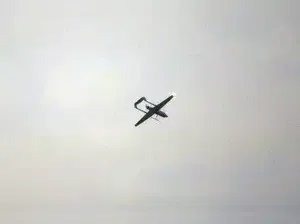Aerial warfare in Africa is trending lighter and nimbler -- and increasingly single-use.
Hulking, fixed-wing military drones were prominently on display at a continent-wide military conference under way in Nigeria this week.
But at a half-dozen expo booths, vendors were also keen to show off their smaller, plastic cousins -- almost identical to drones used by backyard hobbyists, minus the ordnance.
The adaptation of commercial drones for combat -- including in "suicide" missions -- has been closely followed by observers of the Russia-Ukraine war.
More recently it has been documented in west Africa's Sahel region among jihadist groups known to rig their own DIY devices.
The Nigerian military is also in on the trend, as it augments its traditional surveillance and attack drones with cheaper, even disposable, tech.
"They have this in their backpacks, they go for missions and they're able to strike where necessary," said Muhammad Umar, chief technology officer at Nigerian firm EIB Group, which manufactures drones locally and has contracts with the military.
Economically, Umar said, it can make much more sense to send out a small drone that may or may not come back than risk "a half-million-dollar asset" every time.
Turkey's Bayraktar TB2, with a 12-metre (39-foot) wingspan, has become the most popular traditional model among African militaries.
Experts have told AFP that a system of three typically retails for about $6 million -- a steal compared to fighter jets or helicopters.
But Nigerian firm Epsilon sells suicide drones for as low as 1.5 million naira, or just under $1,000, before the cost of explosives.
"You need speed, you need agility," said Oluwagbenga Karimu, a systems autonomy specialist at the company, which also had a booth set up at the African defence chiefs conference in Abuja, which hosted officers from Libya to Malawi to Ethiopia.
- First drones, then jammers -
Drones are increasingly a low-cost means of waging war in Africa but have so far often given mixed military results and devastating consequences for civilian populations, according to an in-depth AFP investigation published in July.
Sudan recorded the highest number of strikes last year, followed by Burkina Faso, Mali and Ethiopia, according to data collected by the Armed Conflict Location & Event Data Project (ACLED), a monitor.
Handheld "quadcopter" and suicide drones supplied by China and Russia in Sudan have further upended fighting in the north African country since it broke into civil war in 2023, according to the US-based Africa Center for Strategic Studies, affiliated with the Defense Department.
Addressing the opening of the conference, Nigerian Vice President Kashim Shettima called on African countries to invest in "indigenous military innovation".
A Nigerian air force official, who declined to share his name, touted the benefits of the handheld drones on display at one of the military's own booths: they don't require a runway and don't produce the tell-tale buzz of higher-powered drones.
The newer drones have proliferated over the past two years, he said, though the air force is still mostly reliant on foreign parts.
The scramble for new drones has also sparked new defensive needs, he added.
As jihadists increasingly use drones themselves, often commercial models modified to drop bombs or grenades, the Nigerian military is now seeking out jamming systems.
Hulking, fixed-wing military drones were prominently on display at a continent-wide military conference under way in Nigeria this week.
But at a half-dozen expo booths, vendors were also keen to show off their smaller, plastic cousins -- almost identical to drones used by backyard hobbyists, minus the ordnance.
The adaptation of commercial drones for combat -- including in "suicide" missions -- has been closely followed by observers of the Russia-Ukraine war.
More recently it has been documented in west Africa's Sahel region among jihadist groups known to rig their own DIY devices.
The Nigerian military is also in on the trend, as it augments its traditional surveillance and attack drones with cheaper, even disposable, tech.
"They have this in their backpacks, they go for missions and they're able to strike where necessary," said Muhammad Umar, chief technology officer at Nigerian firm EIB Group, which manufactures drones locally and has contracts with the military.
Economically, Umar said, it can make much more sense to send out a small drone that may or may not come back than risk "a half-million-dollar asset" every time.
Turkey's Bayraktar TB2, with a 12-metre (39-foot) wingspan, has become the most popular traditional model among African militaries.
Experts have told AFP that a system of three typically retails for about $6 million -- a steal compared to fighter jets or helicopters.
But Nigerian firm Epsilon sells suicide drones for as low as 1.5 million naira, or just under $1,000, before the cost of explosives.
"You need speed, you need agility," said Oluwagbenga Karimu, a systems autonomy specialist at the company, which also had a booth set up at the African defence chiefs conference in Abuja, which hosted officers from Libya to Malawi to Ethiopia.
- First drones, then jammers -
Drones are increasingly a low-cost means of waging war in Africa but have so far often given mixed military results and devastating consequences for civilian populations, according to an in-depth AFP investigation published in July.
Sudan recorded the highest number of strikes last year, followed by Burkina Faso, Mali and Ethiopia, according to data collected by the Armed Conflict Location & Event Data Project (ACLED), a monitor.
Handheld "quadcopter" and suicide drones supplied by China and Russia in Sudan have further upended fighting in the north African country since it broke into civil war in 2023, according to the US-based Africa Center for Strategic Studies, affiliated with the Defense Department.
Addressing the opening of the conference, Nigerian Vice President Kashim Shettima called on African countries to invest in "indigenous military innovation".
A Nigerian air force official, who declined to share his name, touted the benefits of the handheld drones on display at one of the military's own booths: they don't require a runway and don't produce the tell-tale buzz of higher-powered drones.
The newer drones have proliferated over the past two years, he said, though the air force is still mostly reliant on foreign parts.
The scramble for new drones has also sparked new defensive needs, he added.
As jihadists increasingly use drones themselves, often commercial models modified to drop bombs or grenades, the Nigerian military is now seeking out jamming systems.





